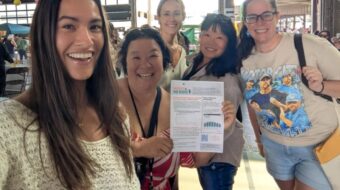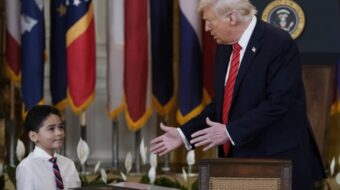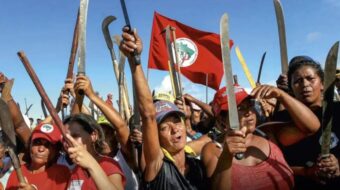Colombian students, on strike since October 12, took to the streets nationwide on November 10. They’ve been protesting a government proposal aimed, they say, at privatizing public higher education. Their leadership group, the Broad National Council of Students (MANE by its Spanish initials) calls for “an alternative education democratic, free, and in the service of the great majority.”
The students oppose proposed “reforms” of Law 30 which President Juan Manuel Santos’ government announced in April. That “Law of Higher Education” has been in effect since 1992. The government is calling for private funding of public higher education, specifically that industries and banks subsidize tuition, salaries, and research programs. Government funding for public universities has lagged far behind mounting costs. Yet funding levels for Colombia’s strong private educational sector have been maintained successfully.
The student strike closed down 32 public universities to some 500,000 students. Demonstrations have been ongoing for a month. Then on November 10 hundreds of thousands of students, joined by teachers, parents, indigenous people, and unionists, marched throughout Colombia, with an estimated 80,000 mobilized in Bogota alone. A nationwide outpouring of protesters had occurred on October 26. Speakers at rallies have evoked the memory of student Yang Cheng Lugo, killed by a bomb thrown at an early rally in Cali.
For social movement leader Diana Sánchez, the recent Bogota march, the largest in decades, was a “novel, creative movement never seen before,” she said, adding “it brings new life to the scenario of Colombian social struggles. It deconstructs the traditional logic of violent mobilizations.”
Reports highlighted extravagant body painting, music verging on the exotic, and resort to “Besaton” – wholesale kissing of police shields. Four hours were required for marchers to pass through Bogota’s Plaza Bolivar.
MANE issued a statement before the November 10 protest that “reiterates commitment to the political and social demands of the Colombian people in defense of their rights, and as such, we identify with rightful struggles for land and health care as a right, for decent working conditions, for sovereignty and against the [U.S.] free trade treaty.” Student leaders asserted also that “defending education as a right is the business of all Colombians.”
Ahead of the marching, President Santos relented to the extent of withdrawing his proposed reforms pending discussions later on with students and university officials. Students were urged to return to classes, although Interior Minister German Vargas warned them of eventual approval of the reforms if demonstrations continued.
At meetings November 12 to 13, the MANE group decided on not ending the strike until the national Congress, where the proposals were under consideration, gave up on them, as did the president. The students demanded that troops leave the campuses and students be allowed to finish the present semester, and that detained students be released. They called for collaborative decision making to shape future educational changes. Meetings between students and Ministry of Education officials began on November 15. The Senate broke off consideration of reforms the next day, fulfilling conditions for the strike to end.
Colombian student leaders have communicated with the British student movement whose protests against educational cuts convulsed British cities almost a year ago. They are taking a lead from beleaguered Spanish youth, who, having demonstrated off and on for six months, set November 17 for major protests in Madrid. In Latin America, Puerto Rican and Chilean students have set the tone with hundreds of thousands of Chilean students rallying over six months for “free, quality education.”
Together Colombian and Chilean students are planning on November 24 as a day of bi-national actions in defense of public education – a “Continental March.” The Colombian students are inviting “Colombian society” to join them. Thus major student mobilizations have materialized in the two South American countries most dedicated to privatization of social services and capitalist inspired neo-liberal reforms.
Colombia’s well-oiled machinery of repression was evident on November 10. Former Colombian Vice President Francisco Santos, the President’s cousin, petitioned legal authorities to authorize the use of electrical crowd immobilization tools. The Black Eagles paramilitary group issued a threat against students at Bogota’s INCCA public university. In Popayán Municipality, riot police and troops using tanks, armed personnel carriers, rubber bullets, and tear gas dispersed 3000 peacefully protesting students, wounding several.









